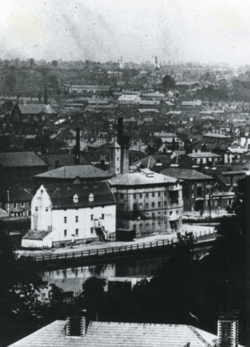Stoke Mill, Ipswich facts for kids
Quick facts for kids Stoke Mill, Ipswich |
|
|---|---|

Stoke Mill, Ipswich, 1880
photographed by William Vick |
|
| General information | |
| Status | Demolished |
| Type | Watermill Tidal mill |
| Location | Stoke Bridge, Ipswich |
| Town or city | Ipswich |
| Country | United Kingdom |
| Coordinates | 52°03′07″N 1°09′11″E / 52.052°N 1.153°E |
Stoke Mill was an old watermill in Ipswich, Suffolk, England. It stood on the north bank of the River Orwell, right next to Stoke Bridge. Today, a skate park is in the spot where the mill once stood on Bridge Street. Mills like Stoke Mill were very important long ago. They used the power of water to grind grain into flour.
Contents
What Was Stoke Mill?
Stoke Mill was a special kind of mill. It was both a watermill and a tidal mill.
- A watermill uses the flow of a river or stream to turn a large wheel. This wheel then powers machinery inside the mill.
- A tidal mill is similar, but it uses the movement of ocean tides. When the tide comes in, water fills a pond or reservoir. When the tide goes out, the trapped water is released. This flowing water turns the mill wheel.
Stoke Mill used the strong tides of the River Orwell. This made it a very powerful and useful mill for the town of Ipswich.
Why Mills Were Important
Before electricity, mills were vital for many tasks. They helped people turn raw materials into useful products.
- Grinding grain: This was the main job for many mills. They turned wheat, barley, and other grains into flour. People used this flour to bake bread and make other foods.
- Sawing wood: Some mills had saws powered by water. They cut logs into planks for building.
- Making paper: Other mills helped prepare materials for making paper.
- Processing cloth: Mills could also be used to clean and thicken wool or other fabrics.
Stoke Mill mainly focused on grinding grain. It helped feed the people of Ipswich and the surrounding areas for many years.
Location and History
Stoke Mill was located in a busy part of Ipswich. It was right by Stoke Bridge, a key crossing point over the River Orwell. This made it easy for farmers to bring their grain to the mill. It also made it easy to transport the flour to markets.
The exact date Stoke Mill was built is not known. However, mills have been in this area for a very long time. Records show that mills existed near Stoke Bridge even in the Middle Ages. This means the site has a long history of industrial activity.
How Tidal Mills Worked
Tidal mills like Stoke Mill needed careful planning.
- First, a dam or wall was built across a tidal creek or inlet.
- This created a large pond or reservoir behind the dam.
- When the tide came in, a gate would open. Water would flow into the pond.
- When the tide started to go out, the gate would close. This trapped the water in the pond.
- As the tide continued to drop outside the dam, the water level inside the pond became much higher.
- This difference in water level created a strong flow. The millers would then open another gate.
- The water rushed out, turning a large water wheel. This wheel then powered the grinding stones inside the mill.
This clever system allowed Stoke Mill to work even when the river flow was low. It relied on the regular rise and fall of the tides.
The End of Stoke Mill
Over time, new technologies emerged. Steam power and later electricity began to replace water power. Large, modern factories could produce flour much faster and cheaper. Because of these changes, many old mills, including Stoke Mill, became less important.
Stoke Mill was eventually demolished. This means it was taken down. Today, you won't see the mill building itself. Instead, a modern skate park stands on the site. This shows how places change over time. What was once an important industrial site is now a place for recreation.
Even though Stoke Mill is gone, its history reminds us of how people used natural power to live and work. It's a small piece of Ipswich's past.
Images for kids


